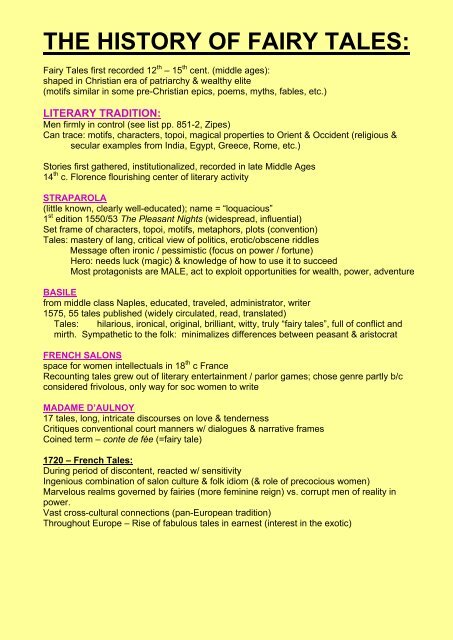HOW TO WRITE BETTER FAIRY TALES - DEAN AMORY
Complete course on writing Fairy Tales (aka Wonder Tales)
Complete course on writing Fairy Tales (aka Wonder Tales)
Create successful ePaper yourself
Turn your PDF publications into a flip-book with our unique Google optimized e-Paper software.
THE HIS<strong>TO</strong>RY OF <strong>FAIRY</strong> <strong>TALES</strong>:<br />
Fairy Tales first recorded 12 th – 15 th cent. (middle ages):<br />
shaped in Christian era of patriarchy & wealthy elite<br />
(motifs similar in some pre-Christian epics, poems, myths, fables, etc.)<br />
LITERARY TRADITION:<br />
Men firmly in control (see list pp. 851-2, Zipes)<br />
Can trace: motifs, characters, topoi, magical properties to Orient & Occident (religious &<br />
secular examples from India, Egypt, Greece, Rome, etc.)<br />
Stories first gathered, institutionalized, recorded in late Middle Ages<br />
14 th c. Florence flourishing center of literary activity<br />
STRAPAROLA<br />
(little known, clearly well-educated); name = “loquacious”<br />
1 st edition 1550/53 The Pleasant Nights (widespread, influential)<br />
Set frame of characters, topoi, motifs, metaphors, plots (convention)<br />
Tales: mastery of lang, critical view of politics, erotic/obscene riddles<br />
Message often ironic / pessimistic (focus on power / fortune)<br />
Hero: needs luck (magic) & knowledge of how to use it to succeed<br />
Most protagonists are MALE, act to exploit opportunities for wealth, power, adventure<br />
BASILE<br />
from middle class Naples, educated, traveled, administrator, writer<br />
1575, 55 tales published (widely circulated, read, translated)<br />
Tales: hilarious, ironical, original, brilliant, witty, truly “fairy tales”, full of conflict and<br />
mirth. Sympathetic to the folk: minimalizes differences between peasant & aristocrat<br />
FRENCH SALONS<br />
space for women intellectuals in 18 th c France<br />
Recounting tales grew out of literary entertainment / parlor games; chose genre partly b/c<br />
considered frivolous, only way for soc women to write<br />
MADAME D’AULNOY<br />
17 tales, long, intricate discourses on love & tenderness<br />
Critiques conventional court manners w/ dialogues & narrative frames<br />
Coined term – conte de fée (=fairy tale)<br />
1720 – French Tales:<br />
During period of discontent, reacted w/ sensitivity<br />
Ingenious combination of salon culture & folk idiom (& role of precocious women)<br />
Marvelous realms governed by fairies (more feminine reign) vs. corrupt men of reality in<br />
power.<br />
Vast cross-cultural connections (pan-European tradition)<br />
Throughout Europe – Rise of fabulous tales in earnest (interest in the exotic)


















